- 2024年-03月-01日:白蛇传(56P)
- 2024年-02月-26日:逼上梁山(17P)
- 2024年-02月-24日:戴敦邦新绘《长恨歌》(51P)
- 2024年-02月-23日:四大名著画集(36P)
- 2024年-02月-23日:戴敦邦聊斋人物谱(113P)
- 2024年-02月-23日:彩绘金瓶梅(98P)
- 2024年-02月-23日:精绘红楼梦插图(50P)
- 2024年-02月-21日:图说唐诗宋词-戴敦邦(104P)
- 2024年-02月-19日:《长恨歌》戴敦邦彩绘-辽宁美术(47P)
- 2024年-02月-19日:《水浒人物壹佰零捌图》[戴敦邦.戴红杰][天津杨柳青版.1997(120P)
- 2024年-02月-19日:《戴敦邦新绘全本红楼梦》.上海古籍出版社(242P)
- 2024年-02月-19日:戴敦邦水浒人物谱(173P)
- 2024年-02月-19日:戴郭邦《封神演义》插图选(50P)
- 2024年-02月-19日:水浒传71回戴敦邦新绘108将(109P)
- 2024年-02月-19日:戴敦邦新绘水浒传(240P)
- 2024年-02月-19日:《红楼梦群芳图谱》(69P)
- 2023年-11月-08日:齐民要术(94P)
- 2023年-10月-30日:历代艳体诗歌精华(728P)
- 2023年-10月-28日:青楼韵语(152P)
- 2023年-10月-28日:性爱大师(417P)
- 2023年-09月-27日:图解金刚经(308P)
- 2023年-09月-20日:《楚辭圖注》十卷【明】(133P)
- 2023年-09月-01日:离骚草木疏.四卷.宋吴仁杰撰.汲古阁.毛氏图史子孙永保之精钞本(52P)
- 2023年-09月-01日:诗经名物图解.10贴.細井徇撰绘.弘化4年自序(486P)
- 2023年-09月-01日:孫子合契(45P)
- 2023年-09月-01日:孙莘老求墨妙亭诗.蘇軾撰.石斎書(12P)
- 2023年-06月-20日:孙子兵法(珍藏版)(205P)
- 2023年-06月-15日:拍案惊奇二集.书前版画(20P)
- 2023年-06月-15日:喻世明言.书前版画(27P)
- 2023年-06月-15日:历代情诗三百首(471P)
- 2023年-06月-14日:醒世恒言.书前版画(40P)
- 2023年-06月-08日:十四行诗·莎士比亚全集40(234P)
- 2023年-06月-08日:露克利斯·莎士比亚全集39(178P)
- 2023年-06月-08日:维诺斯与阿都尼斯·莎士比亚全集38(204P)
- 2023年-06月-08日:波里克利斯·莎士比亚全集37(201P)
- 2023年-06月-08日:辛伯林·莎士比亚全集36(283P)
- 2023年-06月-08日:安东尼与克利欧佩特拉`莎士比亚全集35(281P)
- 2023年-06月-04日:希腊爱经(242P)
- 2023年-06月-04日:奥赛罗·莎士比亚全集34(266P)
- 2023年-06月-04日:李尔王·莎士比亚全集33(266P)
- 2023年-06月-04日:哈姆雷特·莎士比亚全集32(309P)
- 2023年-06月-04日:马克白·莎士比亚全集31(191P)
- 2023年-06月-02日:三才图会之31(432P)
- 2023年-06月-02日:三才图会之30(370P)
- 2023年-06月-02日:朱利阿斯·西撒·莎士比亚全集30(203P)
- 2023年-06月-02日:雅典的泰蒙·莎士比亚全集29(205P)
- 2023年-06月-02日:罗密欧与朱丽叶·莎士比亚全集28(249P)
- 2023年-06月-02日:泰特斯·安庄尼克斯·莎士比亚全集27(203P)
- 2023年-06月-01日:三才图会之29(394P)
- 2023年-06月-01日:三才图会之28(312P)
- 2023年-06月-01日:三才图会之27(306P)
- 2023年-06月-01日:三才图会之26(292P)
- 2023年-05月-28日:三才图会之25(274P)
- 2023年-05月-28日:三才图会之24(242P)
- 2023年-05月-28日:三才图会之23(386P)
- 2023年-05月-28日:三才图会之22(418P)
- 2023年-05月-28日:考利欧雷诺斯·莎士比亚全集26(292P)
- 2023年-05月-28日:脱爱勒斯与克莱西达·莎士比亚全集25(275P)
- 2023年-05月-28日:亨利八世·莎士比亚全集24(261P)
- 2023年-05月-28日:利查三世·莎士比亚全集23(294P)
- 2023年-05月-26日:亨利六世 下·莎士比亚全集22(237P)
- 2023年-05月-26日:亨利六世 中·莎士比亚全集21(247P)
- 2023年-05月-26日:亨利六世 上·莎士比亚全集20(228P)
- 2023年-05月-26日:亨利五世·莎士比亚全集19(249P)
- 2023年-05月-26日:亨利四世 下·莎士比亚全集18(257P)
- 2023年-05月-26日:亨利四世 上·莎士比亚全集17(243P)
- 2023年-05月-24日:三才图会之21(334P)
- 2023年-05月-24日:三才图会之20(430P)
- 2023年-05月-24日:三才图会之19(322P)
- 2023年-05月-22日:语丝·1927年第152、153、154、155期(88P)
- 2023年-05月-19日:利查二世·莎士比亚全集16(227P)
- 2023年-05月-19日:约翰王·莎士比亚全集15(204P)
- 2023年-05月-19日:冬天的故事·莎士比亚全集14(244P)
- 2023年-05月-19日:第十二夜·莎士比亚全集13(214P)
- 2023年-05月-19日:三才图会之18(286P)
- 2023年-05月-19日:三才图会之17(356P)
- 2023年-05月-19日:三才图会之16(296P)
- 2023年-05月-19日:三才图会之15(448P)
- 2023年-05月-16日:皆大欢喜·莎士比亚全集12(231P)
- 2023年-05月-16日:驯悍妇·莎士比亚全集11(215P)
- 2023年-05月-16日:如愿·莎士比亚全集10(210P)
- 2023年-05月-16日:威尼斯商人·莎士比亚全集9(199P)
- 2023年-05月-15日:三才图会之14(392P)
- 2023年-05月-15日:三才图会之13(426P)
- 2023年-05月-15日:三才图会之12(346P)
- 2023年-05月-15日:三才图会之11(490P)
- 2023年-05月-11日:仲夏夜梦·莎士比亚全集8(198P)
- 2023年-05月-11日:空爱一场·莎士比亚全集7(236P)
- 2023年-05月-11日:无事自扰·莎士比亚全集6(211P)
- 2023年-05月-09日:错中错·莎士比亚全集5(159P)
- 2023年-05月-05日:恶有恶报·莎士比亚全集4(219P)
- 2023年-05月-05日:温莎的风流妇人·莎士比亚全集3(219P)
- 2023年-05月-05日:维洛那二绅士·莎士比亚全集2(184P)
- 2023年-05月-05日:暴风雨·莎士比亚全集1(161P)
- 2023年-05月-05日:六「情感西门」·民众版金瓶梅(72P)
- 2023年-05月-05日:五「隔墙密约」·民众版金瓶梅(69P)
- 2023年-05月-05日:四「金莲受辱」·民众版金瓶梅(70P)
- 2023年-05月-05日:一「帘下勾情」·民众版金瓶梅(68P)
- 2023年-05月-05日:旧馆重游·图解金瓶梅之十(104P)
- 2023年-05月-05日:人去楼空·图解金瓶梅之九(104P)
《耕织图》是我国古代为劝课农桑,采用绘图的形式详实记录耕作与蚕织的系列图谱。由于其“图绘以尽其状,诗文以尽其情”,形象生动、细腻传神地描绘了劳动者耕作与蚕织的场景和详细的生产过程,而起到了普及农业生产知识、推广耕作技术、促进社会生产力发展的巨大作用,其本身也成为极其珍贵的艺术瑰宝。《耕织图》是南宋绍兴年间画家楼俦所作,作品得到了历代帝王的推崇和嘉许。天子三推,皇后亲蚕,男耕女织,这是中国古代很美丽的小农经济图景。南宋时的楼俦在任于潜令时,绘制《耕织图诗》45幅,包括耕图21幅、织图24幅。清朝康熙南巡,见到《耕织图诗》后,感慨于织女之寒、农夫之苦,传命内廷供奉焦秉贞在楼绘基础上,重新绘制,计有耕图和织图各23幅,并每幅制诗一章。焦绘耕织图令康熙皇帝龙颜大悦,在序首钤盖了“佩文斋”朱印,在序后钤盖了“康熙宸翰”阳文朱方大印和阴文“稽古右文之章”朱方大印,再命著名木刻家朱圭、梅裕凤镌版印制,颁赐臣工。焦绘《耕织图诗》问世以后,它的墨印彩绘本也开始出现。北京图书馆出版社将墨印彩绘本影印出版,令世人一睹珍品风采,又能了解唐末五代以来墨印彩绘之技法。1933年商务印书馆出版之《东方文库续编》中的《东方艺术与西方艺术》所收之《明清之际中国美术所受西洋之影响》一文,将焦图与楼图作比较:“最为不同者,则焦图应用西洋之透视法以作画是也,”“楼图简单朴素,而焦图则纤细丽都。”据考证,雍正、乾隆两朝都曾几度摹绘、刊行焦绘《耕织图诗》。台北故宫博物院藏有乾隆朝冷枚(焦秉贞弟子、供奉内廷)、陈枚(画家、官内务府员外郎)绘制的焦图的绢本着彩摹绘本,而大连图书馆所藏乾隆时刊印的《御制耕织图诗》则不但有康熙的诗,雍正、乾隆时的御制诗也都赫然在目。美国国会图书馆亚洲部专家居蜜女士提及他们也藏有《耕织图》,真不知《耕织图》会有几许。有意思的是,焦绘《耕织图》成为当时景德镇瓷器中的一种特有纹饰。今故宫博物院藏品中有五彩耕织图碗,画面取“舂碓”和“分箔”两组题材。而楼(左王右为士加冤上加工加吋)的《耕织图》由于选材和表现手法上的长处,后世亦出现不少摹本。清乾隆三十四年(1769)据元代程棨摹本刻石,系阴刻,线条洗练刚劲。图存圆明园贵织山堂,石置多稼轩。1860年圆明园遭八国联军焚掠,程棨本《耕织图》不知所终,刻石被毁;直至1960年,残存刻石终归中国历史博物馆收藏,仅存23石,相当于原45石之一半。到了清代,乾隆帝把清漪园(颐和园)的一处富有田园风光的景色命名为“耕织图”。乾隆皇帝不仅命人绘制《耕织图》,并且将《耕织图》中的美景用实际山水复原出来,把关系到国计民生的衣食之本,用艺术与现实相结合的手法镶嵌在清漪园绚丽的湖光山色之中。《耕织图》的绘制到清朝达到鼎盛,而以《雍正耕织图》最为精美独特,《雍正御制耕织图》是雍正登基以前以康熙年间刻版印制的《耕织图》为蓝本,由清宫廷画师精心绘制而成,共有图46幅,其中耕图织图各23幅,每幅画上都有雍正的亲笔题诗,并盖有“雍亲王宝”和“破尘居士”两方印章。画册用笔精到、设色典雅,人物形象生动、传神,描绘了劳动者辛勤耕作的场景。雍正在《耕织图》中的亲笔题诗,把意境深远的五言律诗和文雅遒劲的书法相结合,诗、书、画达到完美的统一,堪称珠联璧合的宫廷艺术瑰宝。该图册深藏故宫紫禁城武英殿,深藏故宫三百年从未公开展示。到今天已成为非常珍贵的文物与艺术品,被视为镇馆之宝。目前,《雍正耕织图》已被列为国家一级文物。《耕织图》是南宋绍兴年间画家楼俦所作,作品得到了历代帝王的推崇和嘉许。天子三推,皇后亲蚕,男耕女织,这是中国古代很美丽的小农经济图景。南宋时的楼俦在任于潜令时,绘制《耕织图诗》45幅,包括耕图21幅、织图24幅。清朝康熙南巡,见到《耕织图诗》后,感慨于织女之寒、农夫之苦,传命内廷供奉焦秉贞在楼绘基础上,重新绘制,计有耕图和织图各23幅,并每幅制诗一章。焦绘耕织图令康熙皇帝龙颜大悦,在序首钤盖了“佩文斋”朱印,在序后钤盖了“康熙宸翰”阳文朱方大印和阴文“稽古右文之章”朱方大印,再命著名木刻家朱圭、梅裕凤镌版印制,颁赐臣工。焦绘《耕织图诗》问世以后,它的墨印彩绘本也开始出现。北京图书馆出版社将墨印彩绘本影印出版,令世人一睹珍品风采,又能了解唐末五代以来墨印彩绘之技法。1933年商务印书馆出版之《东方文库续编》中的《东方艺术与西方艺术》所收之《明清之际中国美术所受西洋之影响》一文,将焦图与楼图作比较:“最为不同者,则焦图应用西洋之透视法以作画是也,”“楼图简单朴素,而焦图则纤细丽都。”据考证,雍正、乾隆两朝都曾几度摹绘、刊行焦绘《耕织图诗》。台北故宫博物院藏有乾隆朝冷枚(焦秉贞弟子、供奉内廷)、陈枚(画家、官内务府员外郎)绘制的焦图的绢本着彩摹绘本,而大连图书馆所藏乾隆时刊印的《御制耕织图诗》则不但有康熙的诗,雍正、乾隆时的御制诗也都赫然在目。美国国会图书馆亚洲部专家居蜜女士提及他们也藏有《耕织图》,真不知《耕织图》会有几许。有意思的是,焦绘《耕织图》成为当时景德镇瓷器中的一种特有纹饰。今故宫博物院藏品中有五彩耕织图碗,画面取“舂碓”和“分箔”两组题材。而楼(左王右为士加冤上加工加吋)的《耕织图》由于选材和表现手法上的长处,后世亦出现不少摹本。清乾隆三十四年(1769)据元代程棨摹本刻石,系阴刻,线条洗练刚劲。图存圆明园贵织山堂,石置多稼轩。1860年圆明园遭八国联军焚掠,程棨本《耕织图》不知所终,刻石被毁;直至1960年,残存刻石终归中国历史博物馆收藏,仅存23石,相当于原45石之一半。到了清代,乾隆帝把清漪园(颐和园)的一处富有田园风光的景色命名为“耕织图”。乾隆皇帝不仅命人绘制《耕织图》,并且将《耕织图》中的美景用实际山水复原出来,把关系到国计民生的衣食之本,用艺术与现实相结合的手法镶嵌在清漪园绚丽的湖光山色之中。《耕织图》的绘制到清朝达到鼎盛,而以《雍正耕织图》最为精美独特,《雍正御制耕织图》是雍正登基以前以康熙年间刻版印制的《耕织图》为蓝本,由清宫廷画师精心绘制而成,共有图46幅,其中耕图织图各23幅,每幅画上都有雍正的亲笔题诗,并盖有“雍亲王宝”和“破尘居士”两方印章。画册用笔精到、设色典雅,人物形象生动、传神,描绘了劳动者辛勤耕作的场景。雍正在《耕织图》中的亲笔题诗,把意境深远的五言律诗和文雅遒劲的书法相结合,诗、书、画达到完美的统一,堪称珠联璧合的宫廷艺术瑰宝。该图册深藏故宫紫禁城武英殿,深藏故宫三百年从未公开展示。到今天已成为非常珍贵的文物与艺术品,被视为镇馆之宝。目前,《雍正耕织图》已被列为国家一级文物。
The “Farming and Weaving Map” is a series of maps that recorded farming and silkworm weaving in detail in the form of drawings in ancient China in order to persuade students to teach mulberry farming. Because of its vivid and detailed depiction of the scene and detailed production process of labourers’ farming and silkworm weaving, it has played a great role in popularizing agricultural production knowledge, popularizing farming technology and promoting the development of social productivity. It has also become an extremely valuable art treasure. “The Painting of Farming and Weaving” was painted by Lou Fu, a painter in Shaoxing of the Southern Song Dynasty. The work has been praised and praised by the emperors of all dynasties. The emperor pushed three times, the empress loved silkworms, and the men cultivated and women knitted. This is a very beautiful picture of smallholder economy in ancient China. In the Southern Song Dynasty, when they were in charge of Qianling, the Lou couple drew 45 pieces of “Poems on Cultivating and Weaving”, including 21 pieces of ploughing and 24 pieces of weaving. During the southern tour of Kangxi in the Qing Dynasty, when he saw the “Poems of Cultivating and Weaving”, he was deeply impressed by the cold weather of the Weaver Girl and the suffering of the farmer, and ordered the inner court to worship Jiao Bingzhen and redraw them on the basis of the floor painting. There were 23 ploughing and weaving maps, each with a chapter of poetry. The Jiaopai ploughing and weaving drawing greatly pleased Emperor Kangxi Long Yan, who stamped the “Peiwenzhai” red seal at the beginning of the preface, and the “Kangxi Chenhan” red seal at the end of the preface, and the “Jigu Youwen Seal” red seal at the end of the preface, and then ordered the famous woodcarvers Zhu Gui and Mei Yufeng to engrave and print, and awarded them to officials and workers. After the publication of Jiao Hua’s “Poems on Cultivating and Weaving”, its ink-printed and color-painted versions also began to appear. Beijing Library Publishing House will photocopy and publish the ink-printed and color-painted books, so that the world can see the style of treasures and understand the techniques of ink-printed and color-painted since the late Tang Dynasty and the Five Dynasties. In 1933, the article “The Influence of the West on Chinese Fine Arts during the Ming and Qing Dynasties”, which was collected from the “Oriental Art and Western Art” in the “Oriental Library Continuation” published by the Commercial Press, compared the focus map with the floor map: Published and published the “Poems of Cultivating and Weaving Pictures”. The Imperial Palace Museum in Taipei has the silk and color copies of the focal pictures drawn by Leng Mei (disciple of Jiao Bingzhen, worshipping the inner court) and Chen Mei (painter, member of the government’s internal affairs office) during the Qianlong period, while the Imperial Farming and Weaving Poems published during the Qianlong period in Dalian Library has not only the poems of Kangxi, but also the imperial poems of Yongzheng and Qianlong periods. Ms. Jumi, an expert in the Asia Department of the Library of Congress, mentioned that they also have the “Farming and Weaving Map”. I really don’t know how many “Farming and Weaving Map” will be. Interestingly, Jiao’s painting of “The Painting of Cultivating and Weaving” became a unique decoration in Jingdezhen porcelain at that time. Today, the collection of the Palace Museum has a bowl of multicolored ploughing and weaving pictures. The pictures are based on two groups of themes: “chung dui” and “dividing foil”. However, due to the advantages of material selection and expression techniques, there are also many copies in the later generations. In the 34th year of Qianlong’s reign in the Qing Dynasty (1769), according to the Yuan Dynasty, Cheng Yu copied the carved stone, which was carved in the shade, and the lines washed and strengthened. The picture shows the Guizhishan Hall in Yuanmingyuan, with many pavilions in stone. In 1860, the Old Summer Palace was burned and looted by the Allied Forces of the Eight Countries, and the “Farming and Weaving Map” of Cheng Yuben was lost, and the stone was destroyed; Until 1960, the remaining carved stones were finally collected by the Chinese History Museum, with only 23 stones remaining, equivalent to half of the original 45 stones. In the Qing Dynasty, Emperor Qianlong named one of the idyllic scenery in the Qingyi Garden (Summer Palace) “Farming and Weaving Map”. Emperor Qianlong not only ordered people to draw the “Farming and Weaving Map”, but also restored the beautiful scenery in the “Farming and Weaving Map” with the actual landscape, and embedded the basis of food and clothing related to the national economy and people’s livelihood in the beautiful lake and mountain scenery of Qingyi Garden by combining art and reality. The painting of “Geng Wo Tu” reached its peak in the Qing Dynasty, and the “Geng Wo Tu” of Yongzheng was the most exquisite and unique. The “Geng Wo Tu” of Yongzheng Imperial System was based on the “Geng Wo Tu” printed in the reign of Kangxi before Yongzheng ascended the throne. It was carefully drawn by the Qing court painters. There were 46 pictures, including 23 of Geng Wo Tu Tu and 23 of them. Each picture had Yongzheng’s autographed poem, and was stamped with the two seals of “Prince Yong’s Treasure” and “Breaking Dust Dweller”. The picture album is exquisite in brush, elegant in color, vivid and vivid in characters, and depicts the scene of laborers working hard. Yongzheng’s own poem in “The Painting of Farming and Weaving” combines the five-character rhythmic poetry with profound artistic conception and elegant and vigorous calligraphy. The perfect unity of poetry, calligraphy and painting can be called a perfect combination of palace art treasures. The atlas is hidden in the Forbidden City Wuying Hall of the Forbidden City, which has not been publicly displayed for 300 years. Today, it has become a very valuable cultural relic and art, and is regarded as the treasure of the town museum. At present, the “Yongzheng Farming and Weaving Map” has been listed as a national first-class cultural relic. “The Painting of Farming and Weaving” was painted by Lou Fu, a painter in Shaoxing of the Southern Song Dynasty. The work has been praised and praised by the emperors of all dynasties. The emperor pushed three times, the empress loved silkworms, and the men cultivated and women knitted. This is a very beautiful picture of smallholder economy in ancient China. In the Southern Song Dynasty, when they were in charge of Qianling, the Lou couple drew 45 pieces of “Poems on Cultivating and Weaving”, including 21 pieces of ploughing and 24 pieces of weaving. During the southern tour of Kangxi in the Qing Dynasty, when he saw the “Poems of Cultivating and Weaving”, he was deeply impressed by the cold weather of the Weaver Girl and the suffering of the farmer, and ordered the inner court to worship Jiao Bingzhen and redraw them on the basis of the floor painting. There were 23 ploughing and weaving maps, each with a chapter of poetry. The Jiaopai ploughing and weaving drawing greatly pleased Emperor Kangxi Long Yan, who stamped the “Peiwenzhai” red seal at the beginning of the preface, and the “Kangxi Chenhan” red seal at the end of the preface, and the “Jigu Youwen Seal” red seal at the end of the preface, and then ordered the famous woodcarvers Zhu Gui and Mei Yufeng to engrave and print, and awarded them to officials and workers. After the publication of Jiao Hua’s “Poems on Cultivating and Weaving”, its ink-printed and color-painted versions also began to appear. Beijing Library Publishing House will photocopy and publish the ink-printed and color-painted books, so that the world can see the style of treasures and understand the techniques of ink-printed and color-painted since the late Tang Dynasty and the Five Dynasties. In 1933, the article “The Influence of the West on Chinese Fine Arts during the Ming and Qing Dynasties”, which was collected from the “Oriental Art and Western Art” in the “Oriental Library Continuation” published by the Commercial Press, compared the focus map with the floor map: Published and published the “Poems of Cultivating and Weaving Pictures”. The Imperial Palace Museum in Taipei has the silk and color copies of the focal pictures drawn by Leng Mei (disciple of Jiao Bingzhen, worshipping the inner court) and Chen Mei (painter, member of the government’s internal affairs office) during the Qianlong period, while the Imperial Farming and Weaving Poems published during the Qianlong period in Dalian Library has not only the poems of Kangxi, but also the imperial poems of Yongzheng and Qianlong periods. Ms. Jumi, an expert in the Asia Department of the Library of Congress, mentioned that they also have the “Farming and Weaving Map”. I really don’t know how many “Farming and Weaving Map” will be. Interestingly, Jiao’s painting of “The Painting of Cultivating and Weaving” became a unique decoration in Jingdezhen porcelain at that time. Today, the collection of the Palace Museum has a bowl of multicolored ploughing and weaving pictures. The pictures are based on two groups of themes: “chung dui” and “dividing foil”. However, due to the advantages of material selection and expression techniques, there are also many copies in the later generations. In the 34th year of Qianlong’s reign in the Qing Dynasty (1769), according to the Yuan Dynasty, Cheng Yu copied the carved stone, which was carved in the shade, and the lines washed and strengthened. The picture shows the Guizhishan Hall in Yuanmingyuan, with many pavilions in stone. In 1860, the Old Summer Palace was burned and looted by the Allied Forces of the Eight Countries, and the “Farming and Weaving Map” of Cheng Yuben was lost, and the stone was destroyed; Until 1960, the remaining carved stones were finally collected by the Chinese History Museum, with only 23 stones remaining, equivalent to half of the original 45 stones. In the Qing Dynasty, Emperor Qianlong named one of the idyllic scenery in the Qingyi Garden (Summer Palace) “Farming and Weaving Map”. Emperor Qianlong not only ordered people to draw the “Farming and Weaving Map”, but also restored the beautiful scenery in the “Farming and Weaving Map” with the actual landscape, and embedded the basis of food and clothing related to the national economy and people’s livelihood in the beautiful lake and mountain scenery of Qingyi Garden by combining art and reality. The painting of “Geng Wo Tu” reached its peak in the Qing Dynasty, and the “Geng Wo Tu” of Yongzheng was the most exquisite and unique. The “Geng Wo Tu” of Yongzheng Imperial System was based on the “Geng Wo Tu” printed in the reign of Kangxi before Yongzheng ascended the throne. It was carefully drawn by the Qing court painters. There were 46 pictures, including 23 of Geng Wo Tu Tu and 23 of them. Each picture had Yongzheng’s autographed poem, and was stamped with the two seals of “Prince Yong’s Treasure” and “Breaking Dust Dweller”. The picture album is exquisite in brush, elegant in color, vivid and vivid in characters, and depicts the scene of laborers working hard. Yongzheng’s own poem in “The Painting of Farming and Weaving” combines the five-character rhythmic poetry with profound artistic conception and elegant and vigorous calligraphy. The perfect unity of poetry, calligraphy and painting can be called a perfect combination of palace art treasures. The atlas is hidden in the Forbidden City Wuying Hall of the Forbidden City, which has not been publicly displayed for 300 years. Today, it has become a very valuable cultural relic and art, and is regarded as the treasure of the town museum. At present, the “Yongzheng Farming and Weaving Map” has been listed as a national first-class cultural relic.



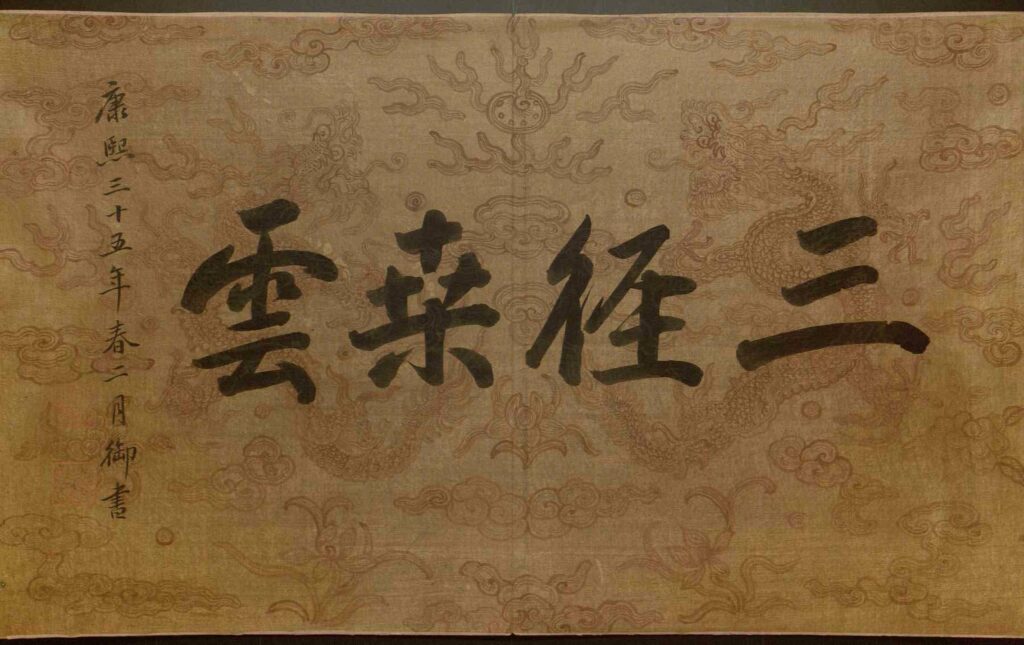


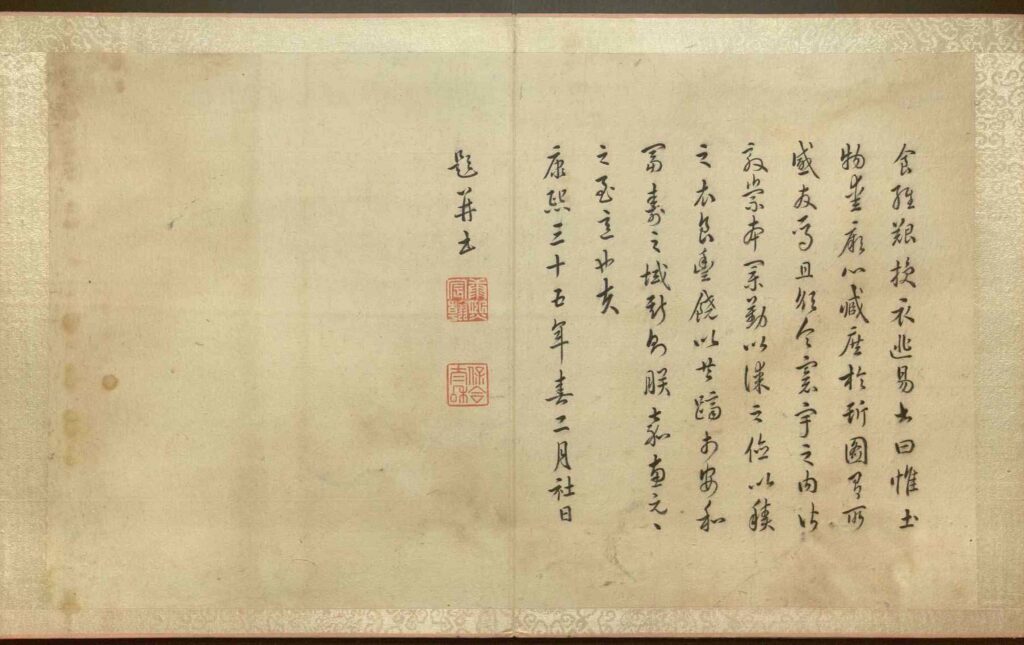
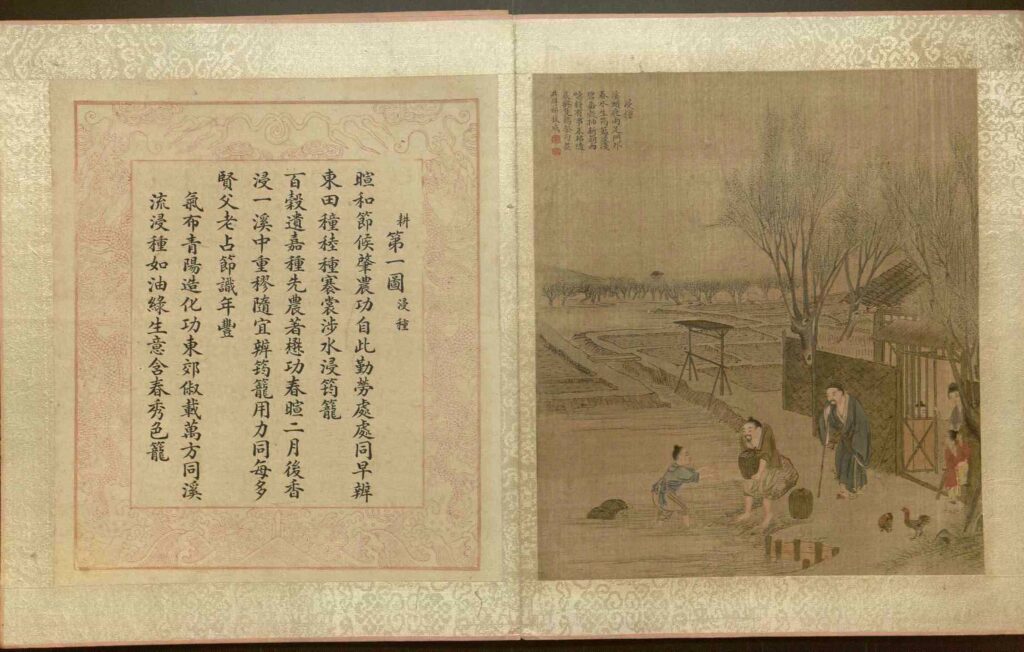


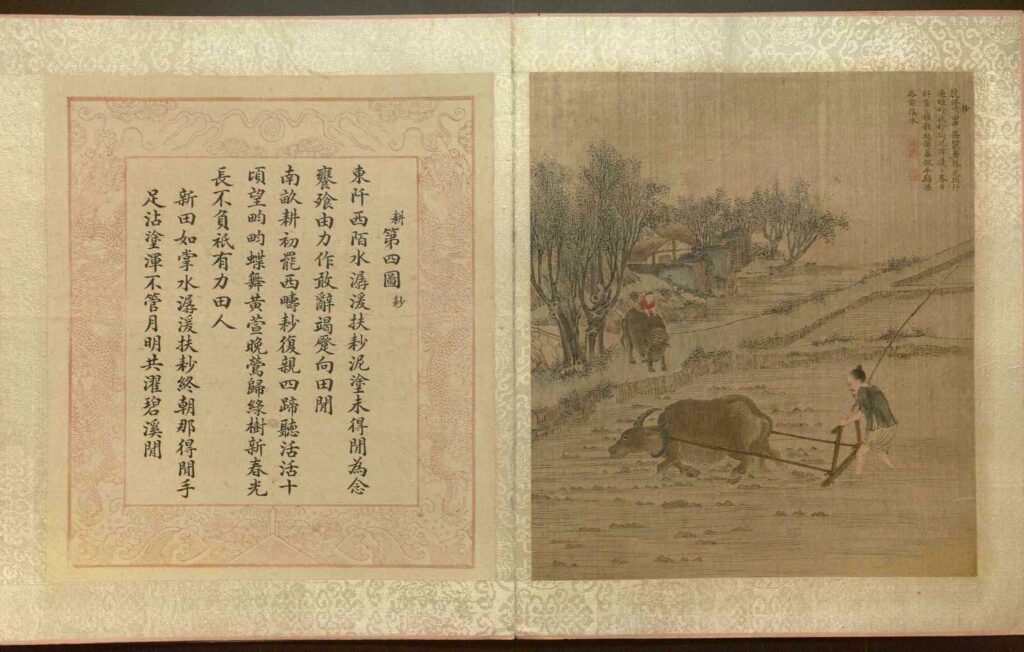




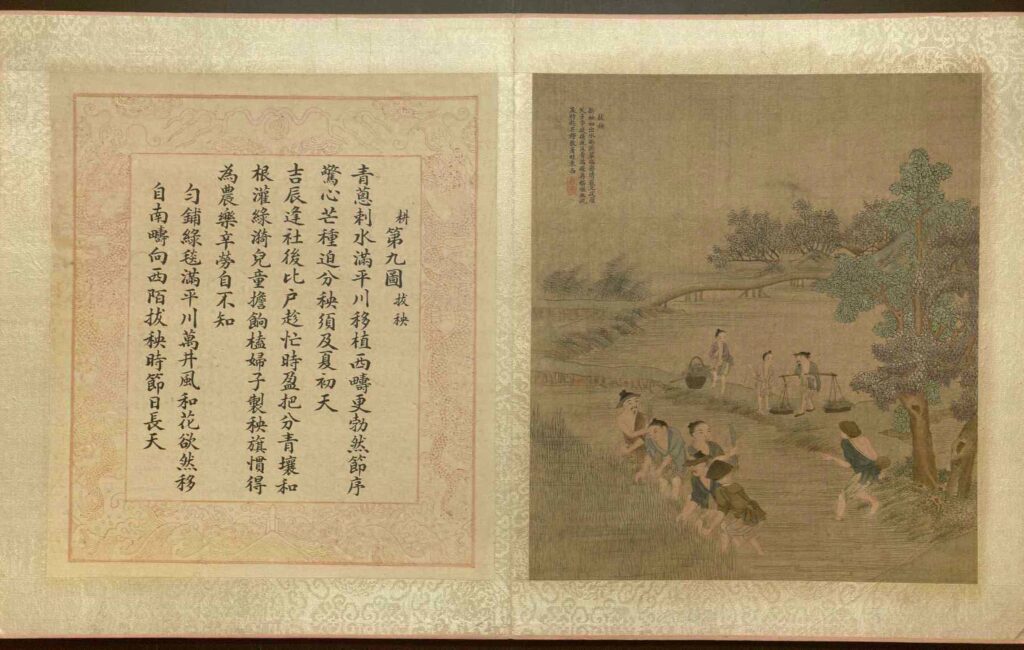

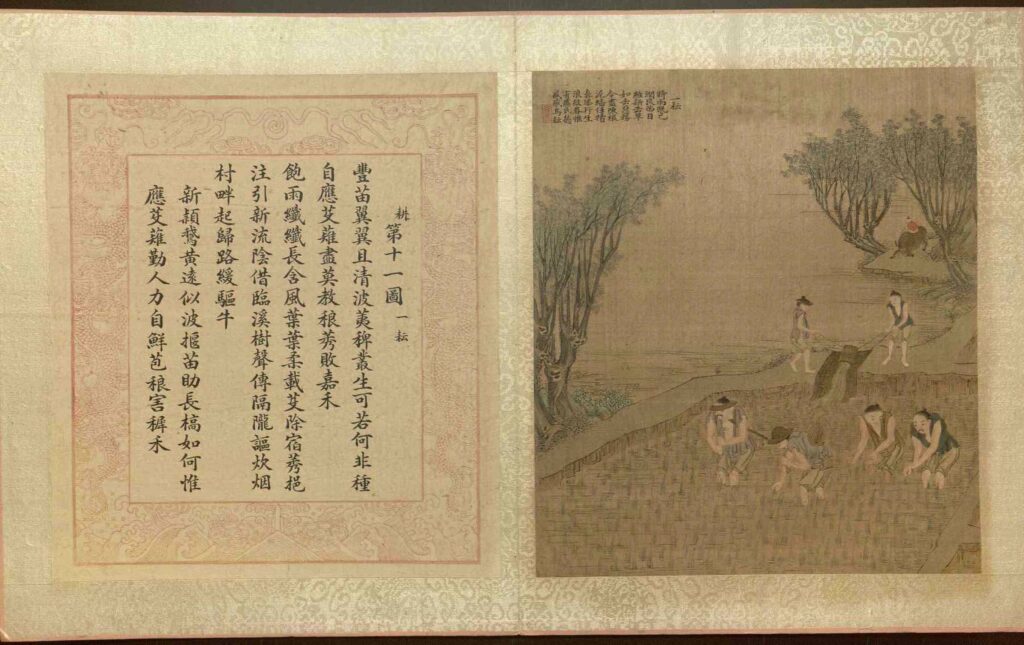
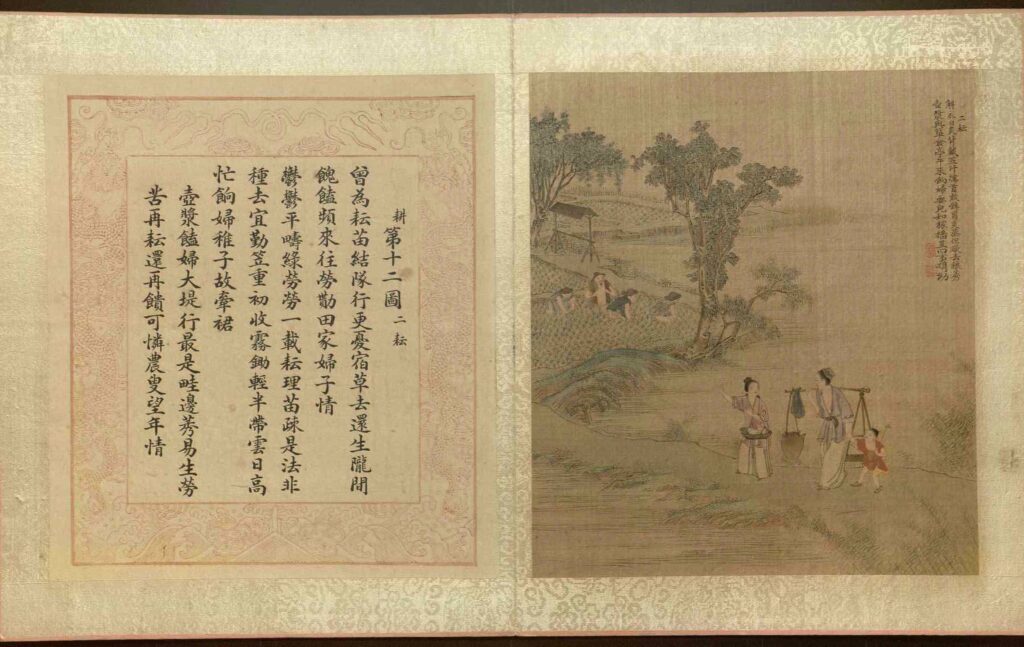



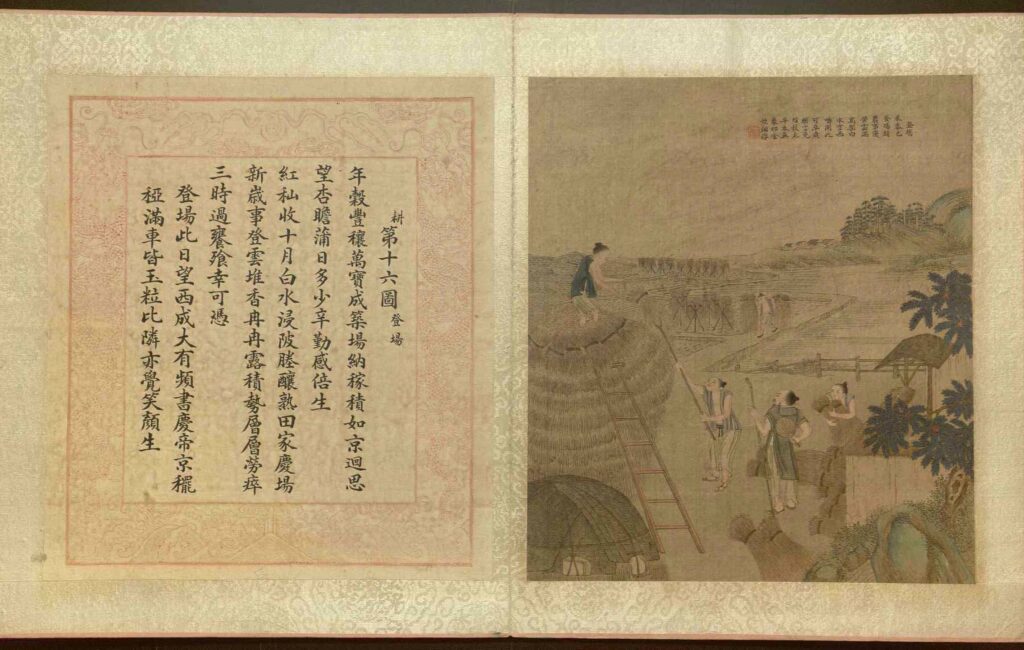
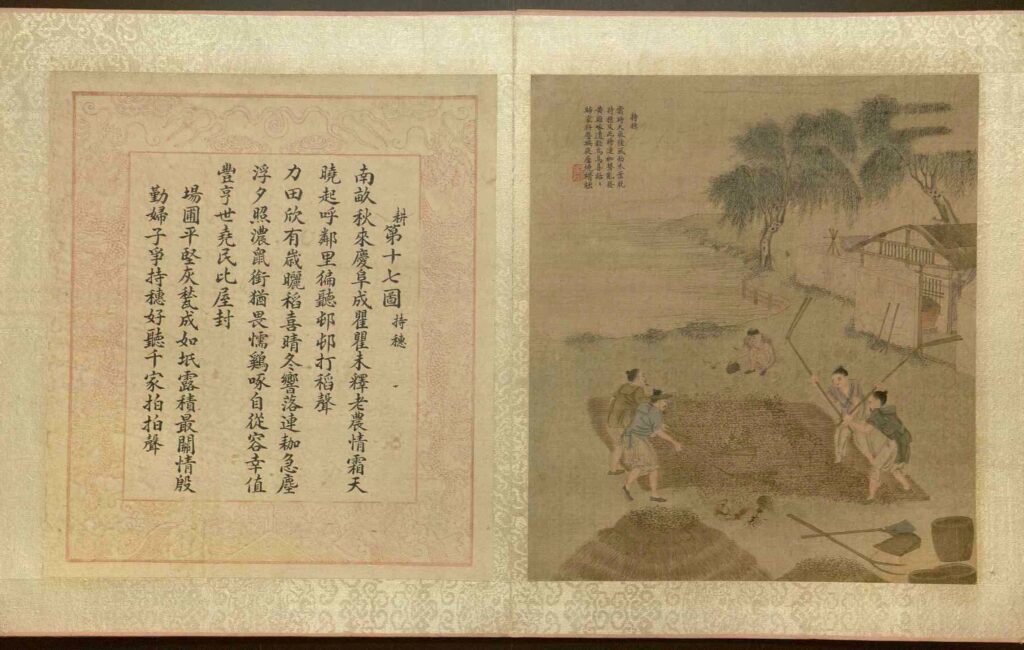


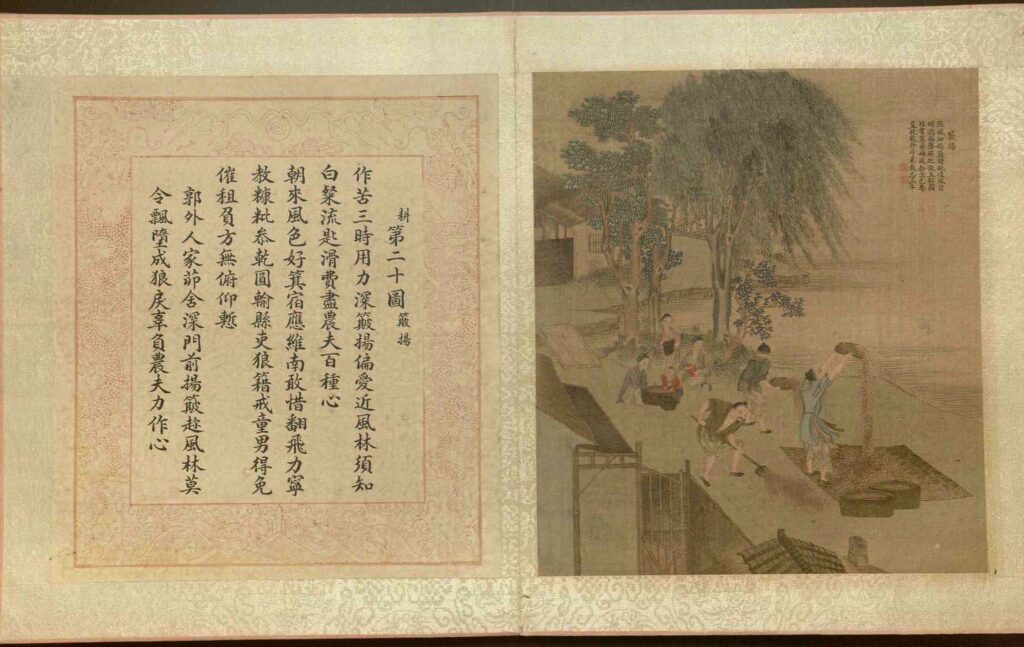
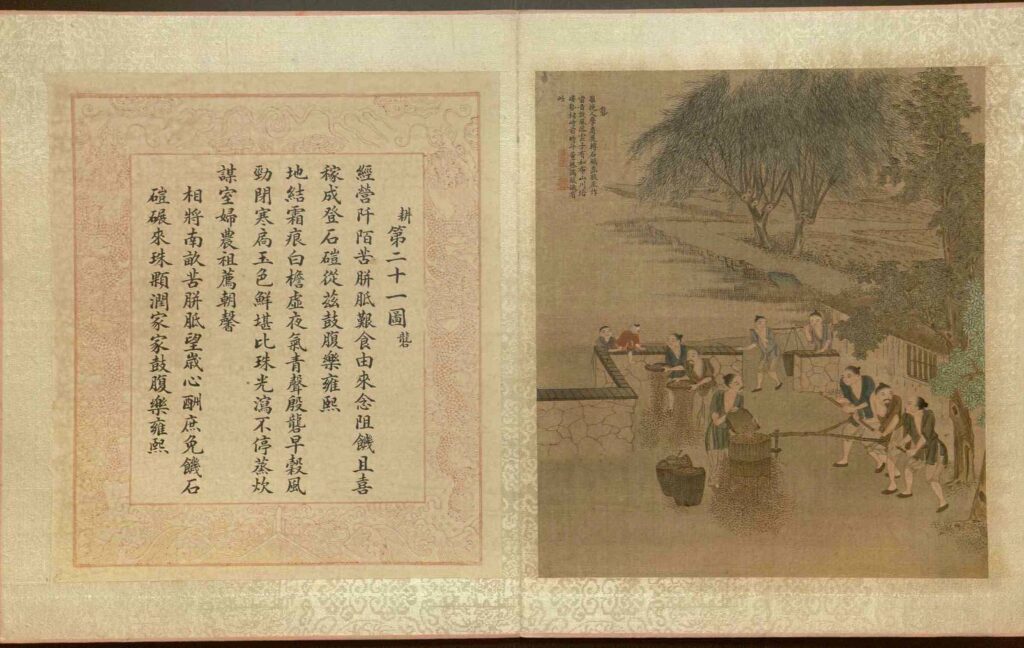



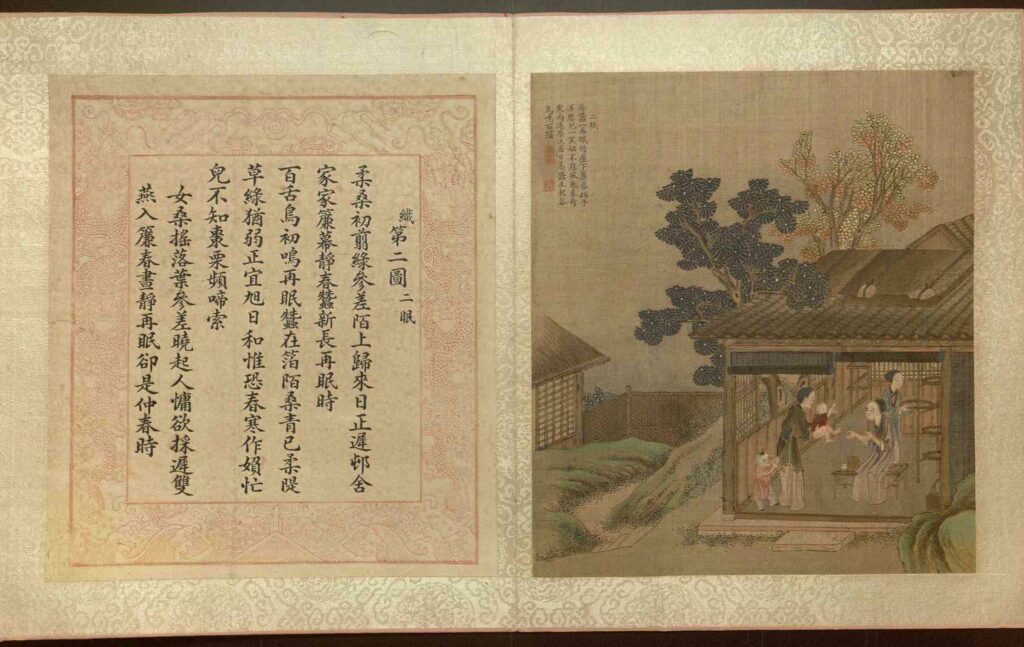

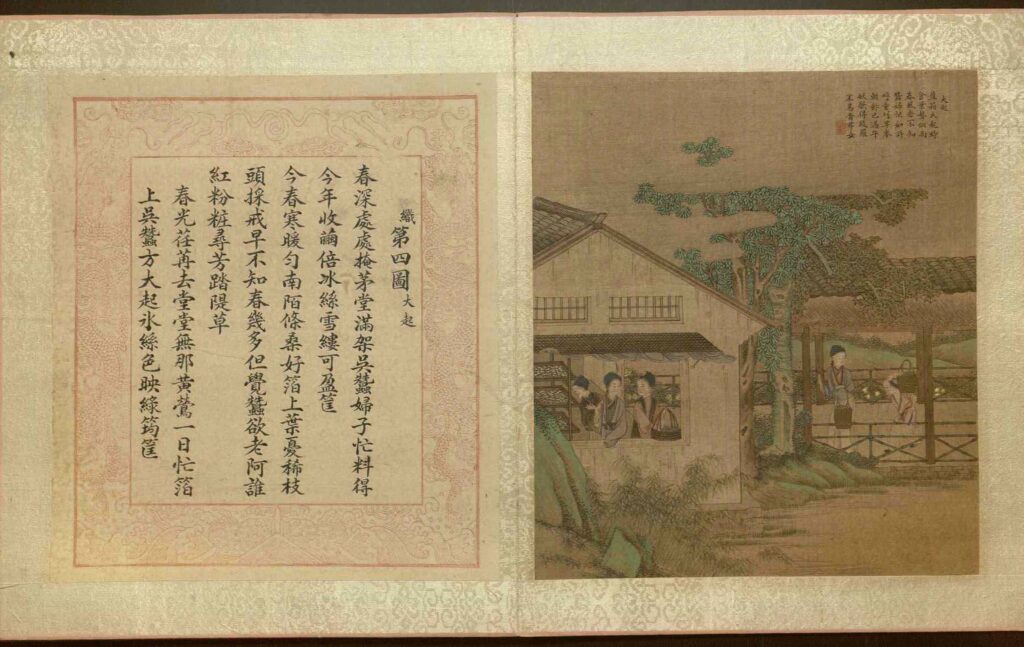





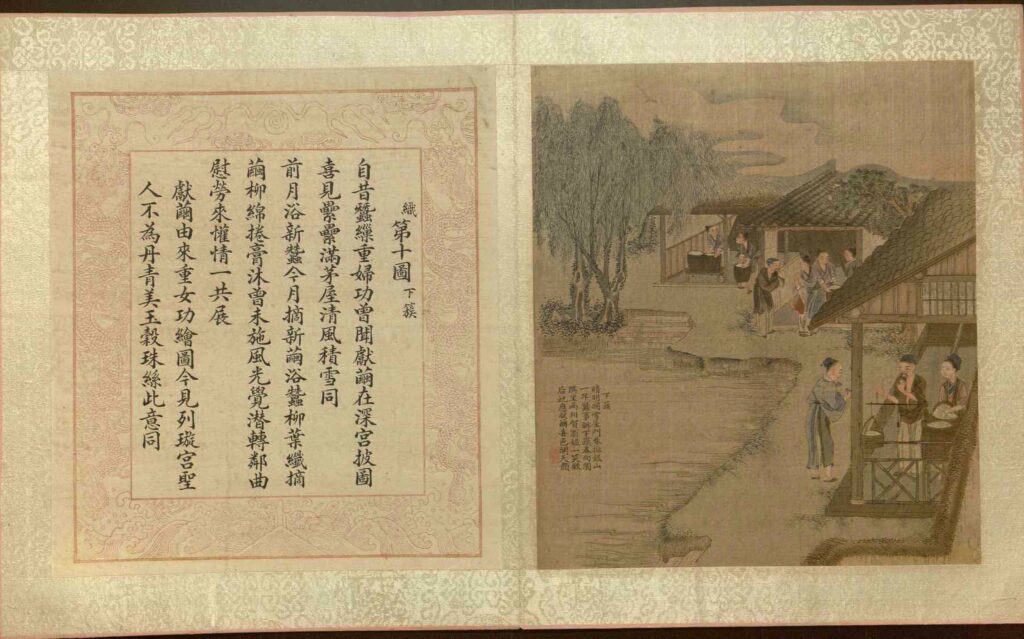
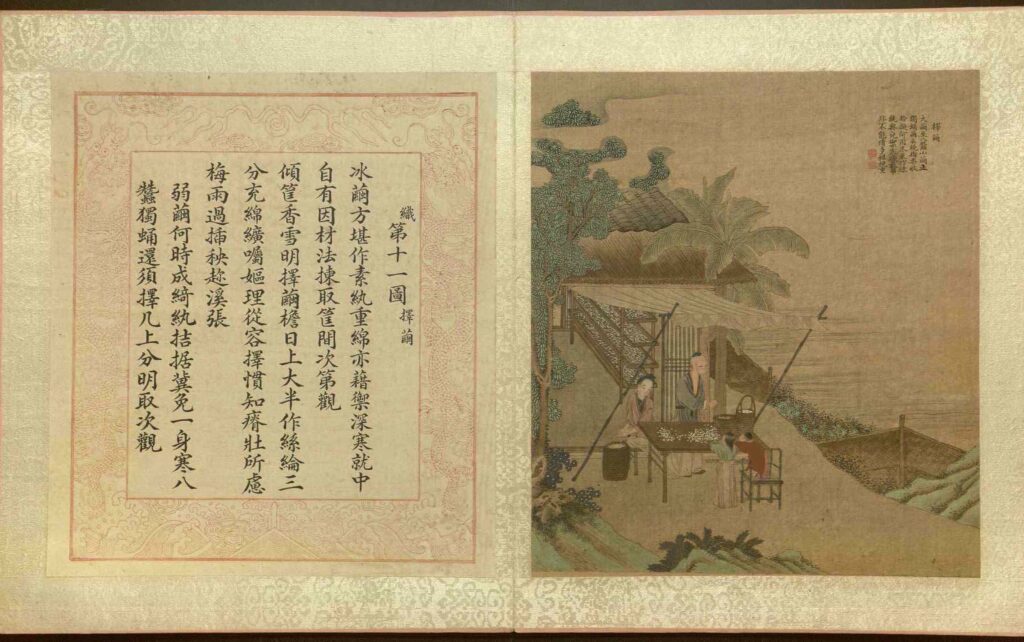


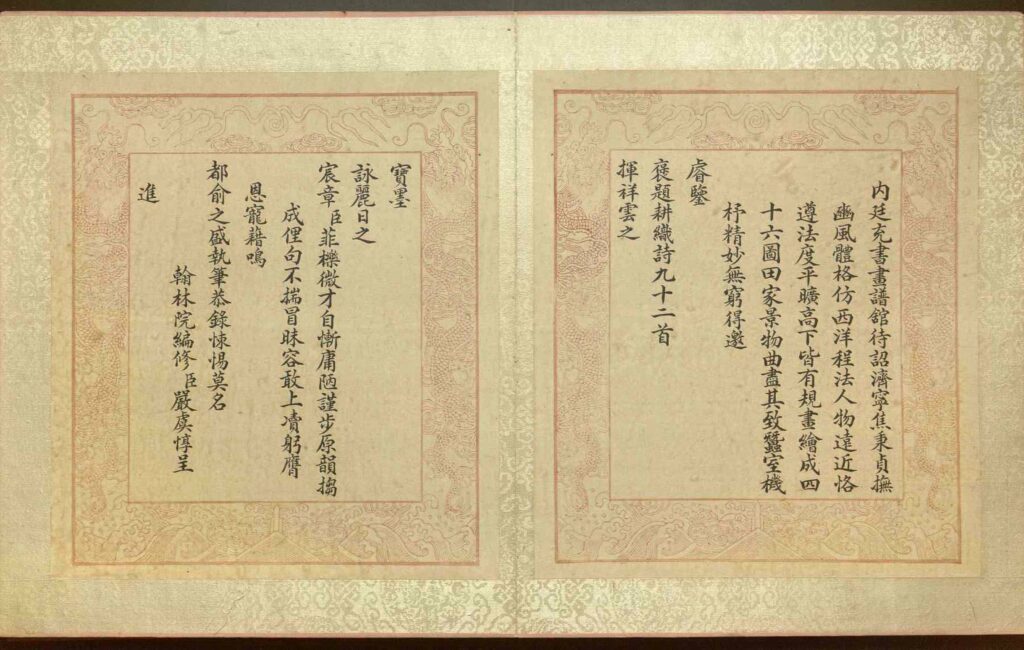
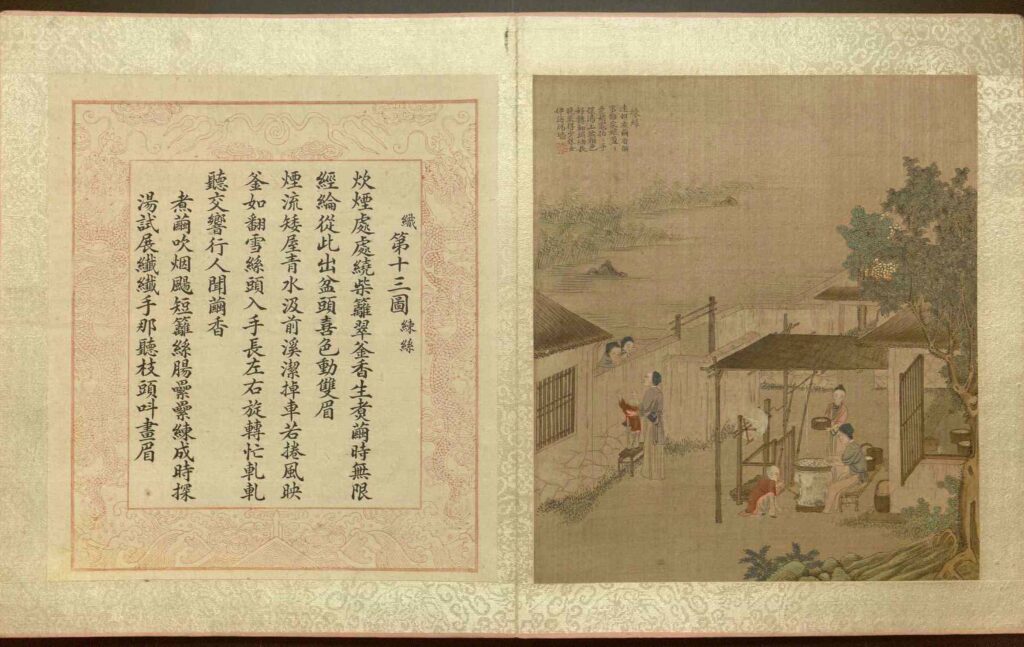


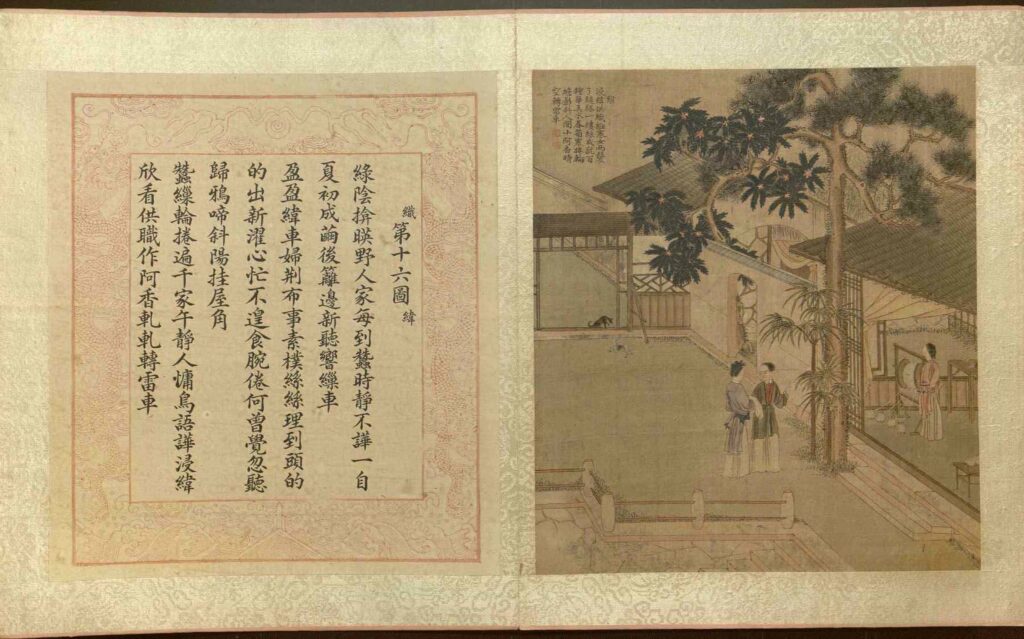
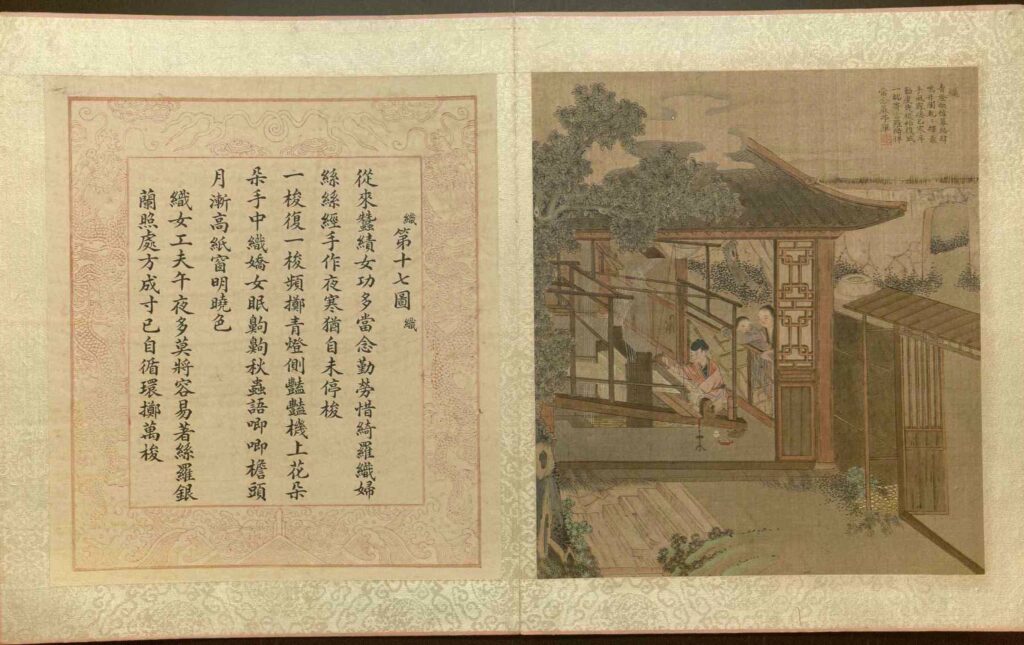
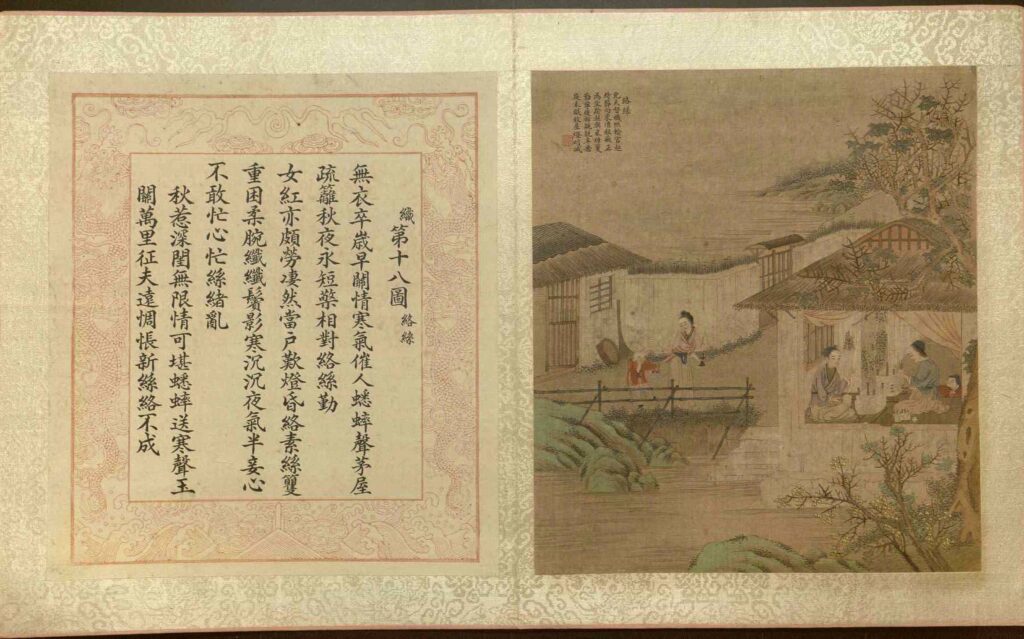



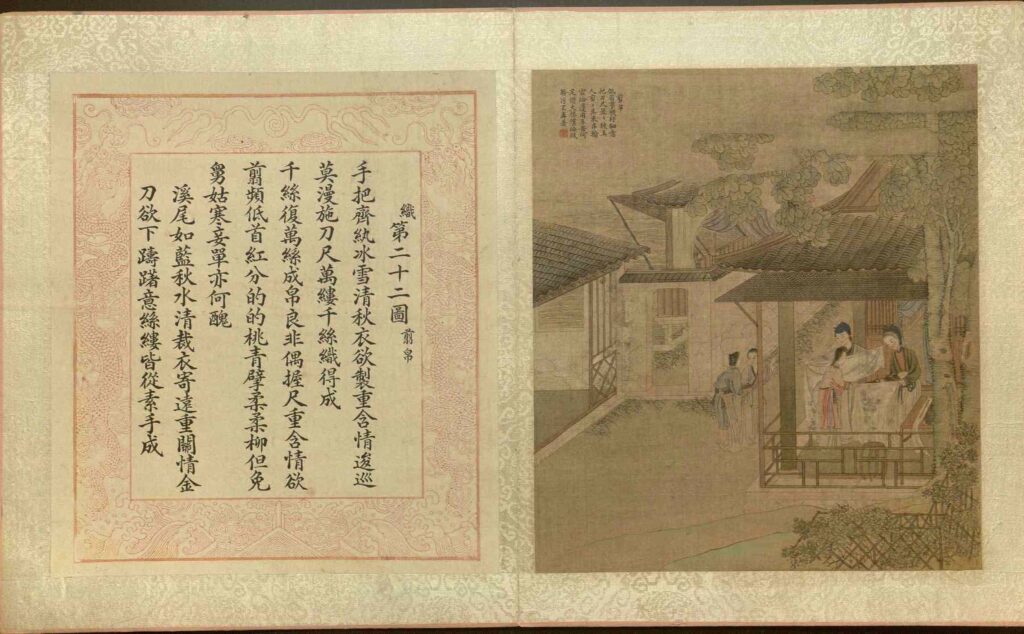

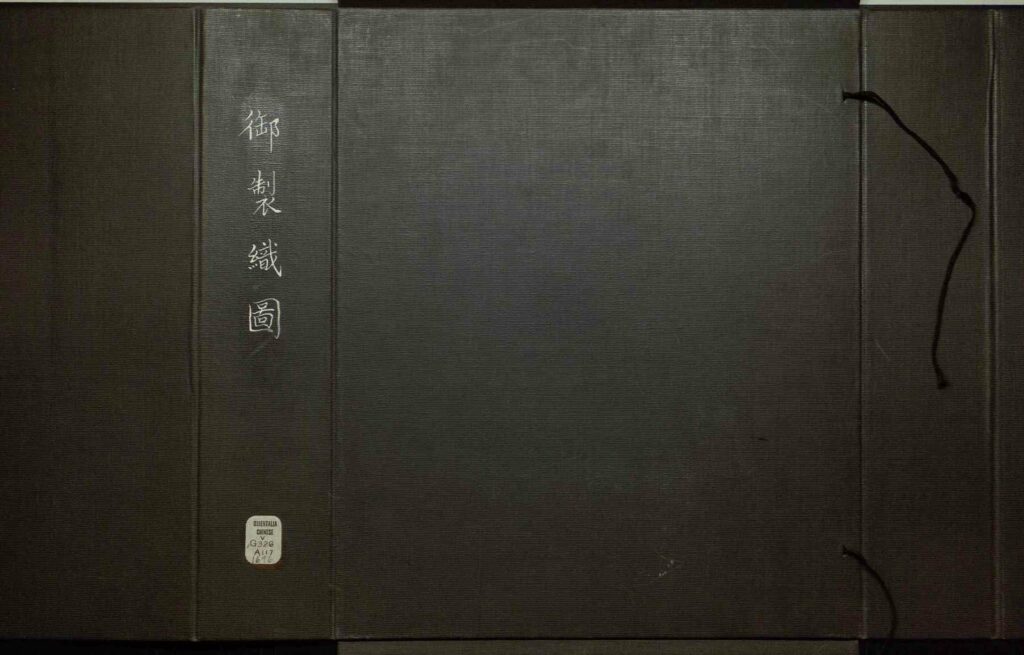
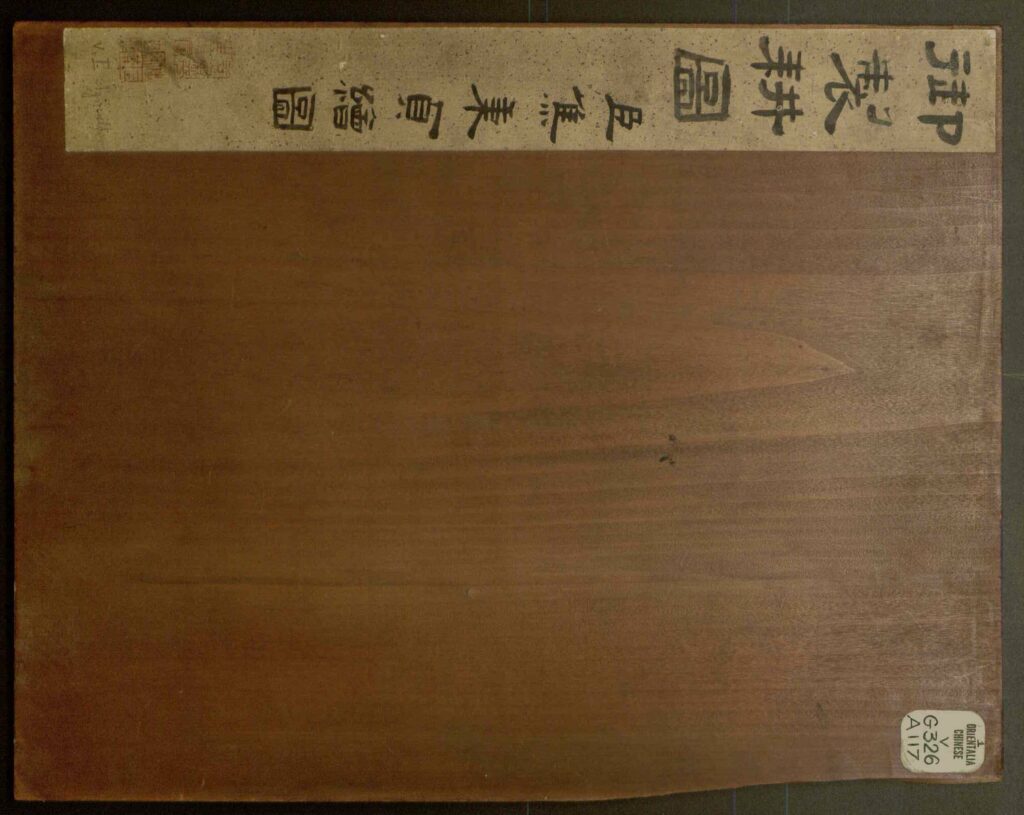
Culture文化 Masterpiece名著 57P 耕织图.焦秉贞画.雍正诗
历史上的今天 ( 1 ):
可点 ➠ 2023年-02月-09日 ➠ 71 s ➠ ♥ 0

